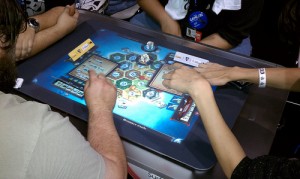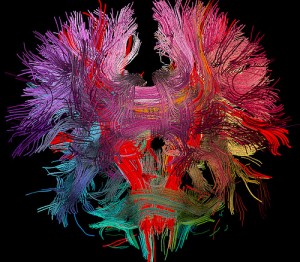Videogames are emerging from their period of infancy and maturing to be one of the most all-encompassing and inspiring entertainment mediums of our time, becoming an increasingly central component of modern culture. It’s well known that in the last few years the industry began to outpace the film industry, bringing in more revenue and positioning itself at the top of the entertainment pile.
What we’re starting to see now is a broadening of the medium into areas that were previously considered out of reach, moving from being perceived as a simple children’s activity to one that can delve into the most mature of narratives and challenge many of our perceptions of identity and expression. Interactive entertainment, particularly in the form of gaming, is going to be one of the key sectors of the 21st century – and so I thought it would be good to have a go at projecting the future of videogames and stimulate some discussion as to where the medium is heading and how quickly it might get there.
2013/14
 Next generation of home consoles is released, with a push towards digital distribution models that create even more difficulty for physical retailers and are detrimental to the second-hand market. Motion and voice controls are built into the core of the system more effectively, and we also see more cross-platform cohesion between consoles and portables already being rolled-out with the likes of the Playstation Vita. Recent concept demos from the Wii U controller show off other forms of this connectivity.
Next generation of home consoles is released, with a push towards digital distribution models that create even more difficulty for physical retailers and are detrimental to the second-hand market. Motion and voice controls are built into the core of the system more effectively, and we also see more cross-platform cohesion between consoles and portables already being rolled-out with the likes of the Playstation Vita. Recent concept demos from the Wii U controller show off other forms of this connectivity.
Some issues will arise from exponentially increasing development costs, technology demands and consumer expectations. Big-budget development will become the domain of an increasingly smaller number of large, multinational corporations – with blockbuster titles focusing even more on tried and true genres that will be developed along franchise iterations to try and maintain a sales base. On the other end of the spectrum, the indy game boom will continue to innovate in areas that require less funding – and even in some instances that do through use of platforms such as Kickstarter – but there will be a big gap between the two funding spheres with little in between.
2015
 Augmented reality gaming starts to take hold through smartphones and glasses technology from the likes of Google which are releasing the technology next year, but expect it to take a few years to achieve any widespread use. Geo-locational gaming becomes more accepted amongst a mainstream consumer audience, and gaming as a general past-time becomes further embedded into daily activities.
Augmented reality gaming starts to take hold through smartphones and glasses technology from the likes of Google which are releasing the technology next year, but expect it to take a few years to achieve any widespread use. Geo-locational gaming becomes more accepted amongst a mainstream consumer audience, and gaming as a general past-time becomes further embedded into daily activities.
There will be a few instances of augmented gaming related injuries as people forget they are still out in the real world, and the safety of these platforms will come into question but will ultimately not be an issue as people adapt to their use. What we’re also going to see are more creative forms of advertising and product placement to replace the current forms which are beginning to fail within these new digital environments.
The connection between home consoles and portable systems will become more comprehensive, and games will incorporate more elements that require real-world interaction through the use of portable devices. This will lead to a boom in alternate reality gaming, bringing the paradigms of videogame culture to our daily activities. In traditional forms of gaming, simulation of accurate physics will become increasingly important as graphics advances begin to see diminishing returns. With the new increases in processing power available we will start to see some incredibly life-like simulations for things such as damage models; whilst also being able to simulate more far-fetched, but highly entertaining, interactions between vast numbers of moving objects or particles.
There will also be more connection between your online and offline personas, with facial-recognition technology relaying your expressions and lip movements into the multiplayer gaming experience. Persistence in gaming will become more prevalent, and there will be an increased emphasis on constantly updating your game through short bursts of activity that can be accessed anywhere. This is something that we currently see in the casual gaming market, but it will become more of a component of complex games and will feed into the experience through various mini-games or ‘side quests’ that allow you to progress your game state for the next time you play.
2018
The first generation of digital distribution only consoles, physical media is no longer used and the service is streamed via cloud storage technology to your entertainment system. These devices combine all of your entertainment needs into a single package – play on demand video, television and music comes along with a subscription to particular gaming platforms which offer certain exclusives and maybe a few different control mechanisms compared to their competitors.
By this stage, retail distribution of games will cease in the form we know currently, replaced instead with public gaming hubs which cater to the many different forms of interactive entertainment. A new arcade renaissance will occur in this sense, and gaming will become an integral part of socialising.
 We’ll also see this social gaming begin to be more prominent in the home environment as well, with interactive coffee tables beginning to become increasingly affordable and meaning that the traditional board-games of nights of years gone by can be augmented by interactive interfaces that not only allow far greater creativity in design but can also do all the rules-keeping for you.
We’ll also see this social gaming begin to be more prominent in the home environment as well, with interactive coffee tables beginning to become increasingly affordable and meaning that the traditional board-games of nights of years gone by can be augmented by interactive interfaces that not only allow far greater creativity in design but can also do all the rules-keeping for you.
New forms of distribution also mean that publishers can be more experimental and indy developers gain more exposure, so we will see much wider diversity in the games being published whilst hopefully also seeing a smaller gap between big-budget and indy developers as gaming engines and construction tools are made affordable that can still push the technology available. We’ll start to see a lot more controversial content as well, exploring the limits of the human condition in both positive and negative forms. The experiences generated will be increasingly open-ended, allowing us to start delving into more challenging and emotionally impacting issues and seeing the resulting outcomes. New outcries from various interest groups will be generated by the realism achievable not only in the physical actions of violent behaviour, but in the resulting displays of emotional artificial intelligence and how they react to this behaviour in ways which could become increasingly disturbing in their realism.
Ultimately the boundaries of the experience will still be dictated to us by the designers (truly emergent gaming will come later…) – but in this sense there will be more examples where games are considered true pieces of art or literature by a wide-range of people and the cultural significance of gaming will become more celebrated, with the result being a much wider diversity in narrative form and content.
2020
Gaming is considered as normal an activity as watching sport on a weekend and will cover almost every demographic. The majority of people in the developed world will have grown up around videogames and there will be very few people who do not have a certain genre of game that appeals to them. Traditional entertainment mediums such as game shows will be produced through virtual multiplayer capabilities and recognition technology embedded into Smart TVs independent of gaming platforms, allowing people to have the chance to take part from the comfort of their own homes.
The interactive nature of gaming technology will also be seen in many different aspects of life, not merely entertainment – for example it will become commonplace to have interactive technology used to train sectors that require finely-tuned motor skills such as medicine or sports. Even fields such as urban planning will be greatly impacted by the increasingly realistic design algorithms being created for games such as the Sim City series. The possibilities for education are endless, and typically quoted examples are things like realistic historical simulations or science classes, whilst architecture and design schools will continue to be at the forefront of the use of new technological capabilities. Fitness will be a past-time that is increasingly undertaken effectively within the home as gaming provides new reward structures, and in response to this gyms will start incorporating more forms of social and individual gaming into their machines and layouts.
Our reliance on technology will increase rapidly by this stage, and it will be very common to see people with permanently on and attached interfaces that are constantly accessible and used to augment the physical experience they are in. E-sports will be considered more mainstream and will be watched in public, and entirely new industries will be developed around supporting the emergence of new e-sport platforms and the infrastructure needed to develop them as professional vocations. Celebrity culture will emerge around the best gamers, designers and developers; and user-created streams that revolve around gaming culture in all its variety will be more watched than almost any other form of entertainment media.
2025
 Virtual reality simulations begin to become viable in the home market, and unlike the augmented reality techniques that have been in favour for the last ten years these will begin to feature fully immersive systems. These experiences will still feel somewhat detached from reality though, as control mechanisms will require various forms of static activity (hand motions, eye movements, traditional controller sticks).
Virtual reality simulations begin to become viable in the home market, and unlike the augmented reality techniques that have been in favour for the last ten years these will begin to feature fully immersive systems. These experiences will still feel somewhat detached from reality though, as control mechanisms will require various forms of static activity (hand motions, eye movements, traditional controller sticks).
The immersion will come from the use of light-weight, non-intrusive headsets or contact lenses and glove sensors that provide the immersive audio-visual, tactile experience needed to suspend disbelief as images are projected directly onto your retinas in stereoscopic detail whilst your hand motions are transferred with 100% accuracy as well as tactile feedback.
Graphics and physics technology by this stage will be able to perfectly mimic real-world resolutions and depth, with added emergent behavioural algorithms allowing sandbox gaming and interaction with characters and environments that promote personally crafted narrative experiences. The MMOs of this era will be infinite in scope and continuously updating themselves with content from algorithms, designers users; and possibly even interchangeable with just a single identity across multiple platforms and games. Viewing other people’s emergent playback recordings will become a regular past-time, and entire entertainment series will be situated around writers and directors using the technology to tell traditional as well as non-linear, multi-protagonist forms of narrative for viewers to later experience whilst also bringing the concept of ‘reality television’ to a new level.
2030
The relational paradigm between user and machine will change as neural signatures are used as primary input methods for interaction with digital environments. Whereas before input schemes would rely on fixed boundaries (press button X, wave hand, move analog stick) game platforms will have to go through a process of learning about each user’s unique brain patterns and adapting accordingly. Initially used as a control scheme, this will pave the way for deeper emotional attachments and emergent story-telling as gaming environments can respond to the emotions of the individual using them.
 If the game is supposed to evoke fear, it could very gradually ramp up particular imagery or situational experiences that the individual user is responding to with anxiety – phasing out aspects that are not getting the desired effect and making those that are become more prominent and intense. Likewise, interaction with in-game characters will become much more lifelike as artificial intelligences are able to be informed by the neural activity of the player as to what they like or are put off by and respond accordingly (even provoking the player intentionally). Intense gaming experiences such as action-based violence will be able to be paced perfectly according to the feedback from the player, with action increasing when the player is feeling more calm and maintaining a certain level of adrenaline within the individual by customising the experience to them.
If the game is supposed to evoke fear, it could very gradually ramp up particular imagery or situational experiences that the individual user is responding to with anxiety – phasing out aspects that are not getting the desired effect and making those that are become more prominent and intense. Likewise, interaction with in-game characters will become much more lifelike as artificial intelligences are able to be informed by the neural activity of the player as to what they like or are put off by and respond accordingly (even provoking the player intentionally). Intense gaming experiences such as action-based violence will be able to be paced perfectly according to the feedback from the player, with action increasing when the player is feeling more calm and maintaining a certain level of adrenaline within the individual by customising the experience to them.
Non-action gaming experiences will be far more predominant than they ever have been, as they begin to be tailored to the wants of each player and a much wider demographic that are seeking experiences beyond traditional competitive, adversarial models. Romantic experiences will be seen more often in games, with relationships becoming central components of particular genres, and sexual activity will as always be a profitable sub-culture but will also be dealt with in a more nuanced manner as part of mainstream games.
The use of videogames as a medium beyond entertainment will see great leaps at this point, as the ability to cater the technology to different forms of behavioural therapy, educational use or other personal or group development will enable more people to grapple with aspects of the human condition that can sometimes be difficult to address or, in the case of mental health for example, are often stigmatised. Of course, with an effectiveness in these areas there are also increases in less positive uses, such as social conditioning or emotional manipulation that could be used by numerous ideological or political movements.
This change in the relational paradigm will mean that gaming becomes a direct projection of as well as influence on our personal and group identities in an ever evolving feedback loop. By this stage it’s incredibly difficult to predict how it will be used, but we can be certain that such an all-inclusive interactive medium will impact every area of human life and will allow us to explore every creative or even destructive avenue that we are capable of.
2045
– The Holodeck (shown here in its current-day form) will achieve its true potential. I’m not sure I have to say much more about this, because really it’s going to be the end point of any timeline of the future of videogames. Every other iteration mentioned in this timeline will still be present, and there will be interactive elements embedded into every aspect of our modern societies – gaming or otherwise. Every aspect of what has already been discussed will continue to develop along its own lines and become increasingly culture forming, from augmented reality applications to e-sports (and there’ll always be a market for authentic retro gaming). But the ultimate entertainment medium comes in the form of limitless creative potential and expression. There’s nowhere you can really go from here, as all experiences imaginable will be achievable. They can be as real or fantastical as you would want them to be, catered to any genre or style, tailored in each instance to be a unique experience.
There won’t even necessarily need to be development teams behind the experiences, as artificial intelligences and sets of emergent experience algorithms could take care of all such activity (albeit based on remarkably erudite levels of platform engine coding, which will likely be the result of modular software applications). There will be more focus on people who can design the parameters for good experiences rather than hard-code them, a reverting back to the story-teller archetype over technical expertise.
At this point the line between games and reality truly becomes blurred to the point of being irrelevant, and there will be countless discussions as to the ethics of such technology, the impact it has on our psychology and identity, and whether we should place any boundaries on its use. But such a discussion is best kept for another time…
I hope you’ve enjoyed this thought-exercise in considering where videogames will be going over the next few decades. It’s difficult to write such a piece, more difficult than I expected it to be, so it’s important that you leave your thoughts in a comment below and add in anything that’s been missed!
What do you think the future of videogames will be?




